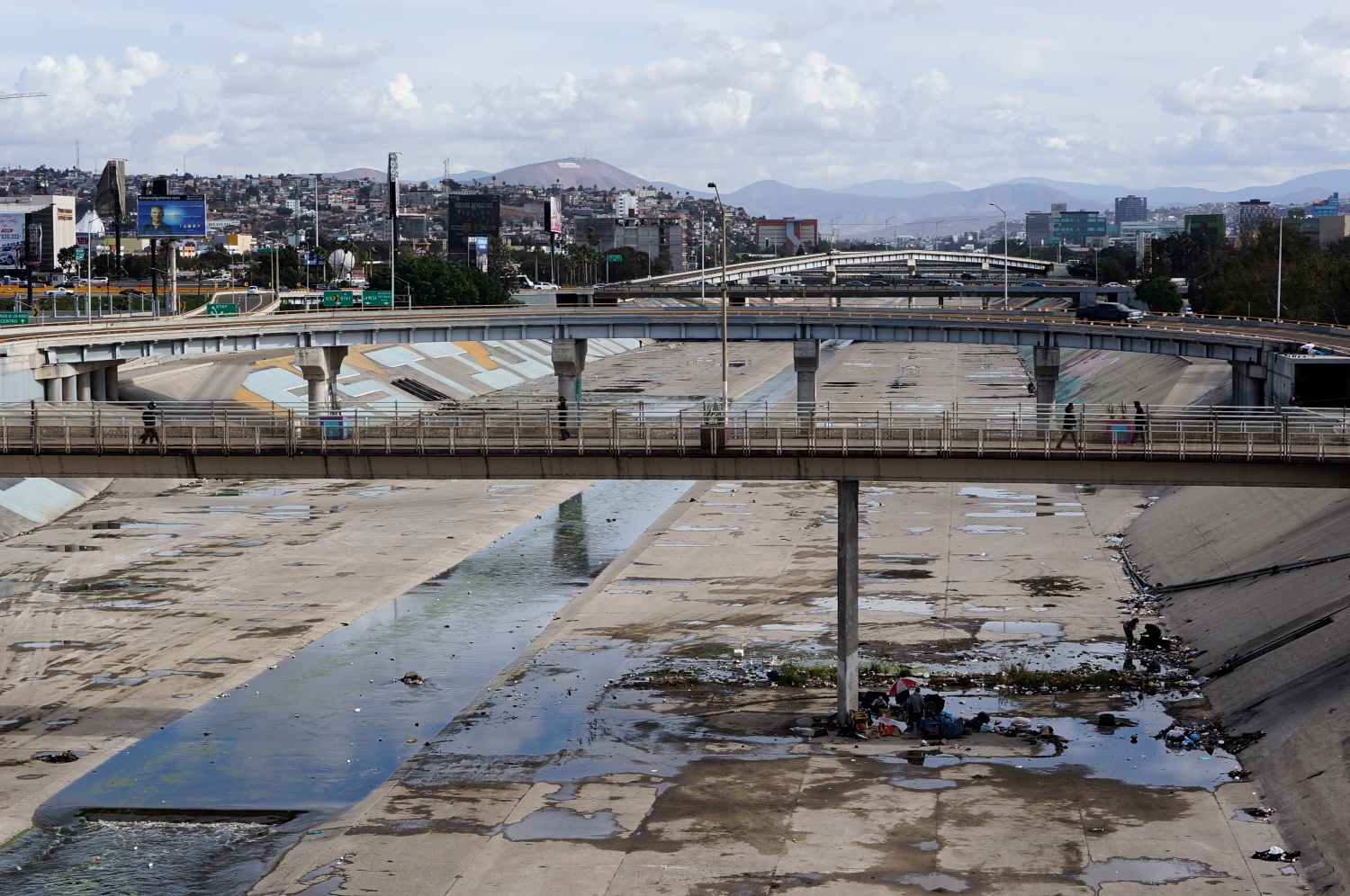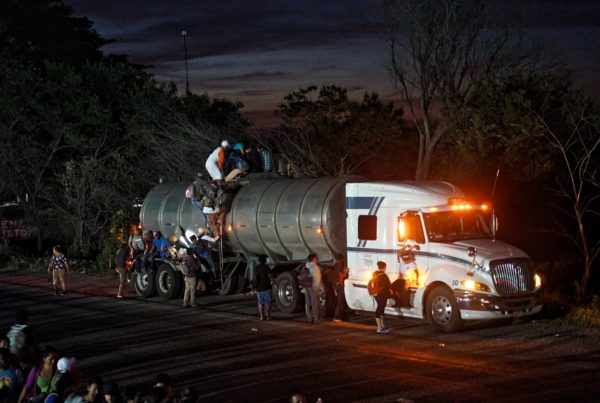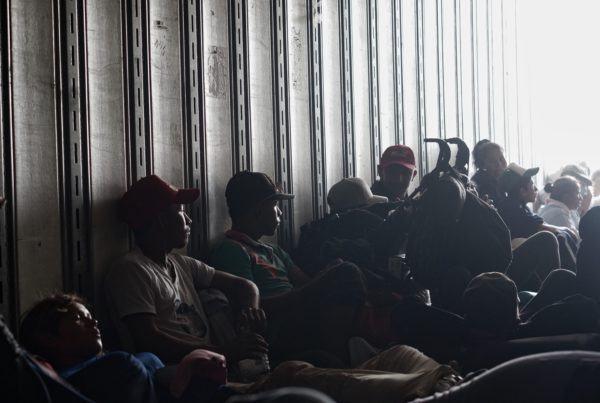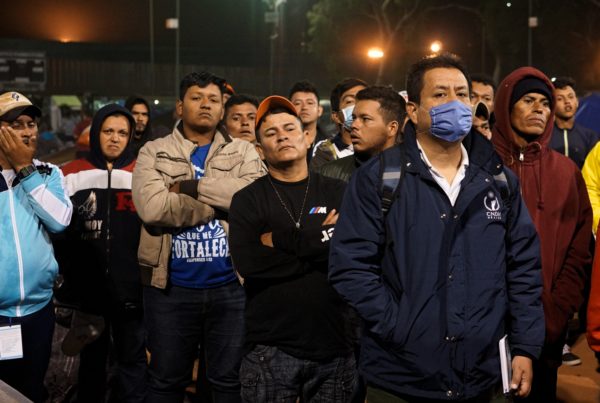Tijuana is a border city located at Mexico’s north-western most point. On the Mexican side of the border there is a bustling city; on the US side there is vacant land. The blinking of lights of San Diego can be seen from Tijuana beach at night. I find border towns strange places. The concepts of borders and migration is hazier when you can stand and look over the imaginary line which is supposed to divide laws, customs, people, and cultures.
Every day, people travel between Mexico and USA for work. Work opportunities in Tijuana attract Mexicans from all over the country but particularly the nearby states of Sinaloa and Sonora. There are US citizens living cheap in Mexico while working on the more profitable US side of the border. There are US citizens who have fled to Mexico to escape troubles. In the hostel where I stay there are travellers who have had their visas to the US refused. Haitian migrants try to wash car windows. Seventy yards from the border there is the deported veterans office.
Prior to arriving in Tijuana, my knowledge of the city was informed by American television shows and popular culture which portrayed the place as a shady border town of criminals and illicit drugs consumed by young Californian partygoers.
“Welcome to Tijuana, tequila, sex and marijuana,” Brazilian musician Manu Chao sings.
That Tijuana exists in the brothels and bars of Zona Norte, one of the largest red light districts of North America. From Zona Norte you can reach the border by crossing the dry, concrete banks of what used to be the Tijuana River. Nowadays the river is more or less a stream of stormwater filled with rubbish; an area occupied by homeless people. In the centre of town there is a tourist district and CBD. The hills between the centre of town and the richer beach suburbs are populated by shanty houses. The border wall is ever-present. In places it appears well-fortified and is manned by US customs officials. In the rugged hillside opposite the shanty towns of Tijuana it is rundown and looks more like the fencing for an abandoned railway yard. At Las Playas de Tijuana, the famous border wall extends into the sea; a rather pathetic display of futility. It is a tourist attraction at the end, or the beginning, of the beach boardwalk.
Most members of the caravan are housed in a sports arena, located in the Zona Norte red light district. All guest houses in Tijuana are at capacity. The street entrances to the sports arena are blockaded by barriers and police cars. A group of locals serving free soup out the front of their house warn me that the area is dangerous.
“People will kill you for your valuables here. Be careful. Don’t walk around at night.”
Despite these warnings, the neighbours in the street for the most part are friendly and respond positively towards the migrants.
Within the sports arena, people sleep on the orange dirt of a baseball pitch. Some sleep in and underneath the stands. One family has taken over the dugout. By now their strategies are tried and tested. Most have waterproof covers. The lucky ones have tents to pitch. Tina, Antonio and Pedro do not. The trio of Hondurans who I first met in Oaxaca missed the generosity of Mexico City where many people received warm clothing and mattresses. Antonio and Pedro need new underwear. Tina doesn’t even have a jumper. They sleep under blankets which are no match for dew or wet weather. On the evening of Wednesday 21 November, it rains heavily and they endure a miserable night. The next day they camp inside a neighbour’s waterproof shelter.
The other group I’ve been following – Jenni, Christian and David – are sleeping in the gymnasium with the children and families. In this hall over one hundred people share body warmth through the cold nights. Donated blankets and soft mattresses make the sleep much more comfortable than what Tina, Antonio and Pedro endure.
There have been mixed reactions from the people of Tijuana. On a daily basis ordinary people come to the Benito Juarez sports arena and offer free food and clothes. However, last week there was an anti-migrant protest which attracted no more than 100 people and a vulture-like media pack. Their message was amplified more by their anger than their numbers.
“Get out you dogs,” they screamed at the families of the Exodus.Jenni was shocked by the visceral emotion.
“They hate us,” she whispered.
There was also violence directed at members of the Exodus and its LGBTQI community staying in Las Playas, Tijuana.]
There is constant talk about the caravan among the residents of Tijuana. I hear it in taxis and cafes and on the street. There are complaints about the way the migrants have arrived, the waste produced by the caravan and the hygiene of its members, and unsubstantiated claims of violence. Some people complain that the migrants don’t want to work and are leaching off the state. This seems unfair as the people have only just arrived in the city and their future is uncertain. In the coming weeks, a careers fair is arranged to help members of the caravan find work. Reports were spread by right-wing media that migrants were throwing away free food. Discarding donated Mexican beans is symbolic of rejecting Mexican hospitality.
Those people who complain about the caravan use the Haitian migrants as an example of how the migrants should act. Haitians started to arrive in Tijuana in 2016. Most came from Brazil where they had found work following Haiti’s devastating earthquake in 2010. When Brazil’s economy suffered a major downturn and jobs became scarce, many Haitians began leaving for the U.S. border. They travelled for months by land all the way to the US-Mexico border, in a manner not dissimilar to the caravan. The story goes that since they arrived in Tijuana, while they wait for entry into the US, they have found work and acted as model citizens.
Tijuana is a border town populated by migrants. Central American migration through Mexico and Tijuana is not a new issue. But what seems to have local people concerned is the sheer number of people arriving. Ironically, the strength in numbers that initially gave the people of the caravan security to travel through Mexico is now causing them problems on the border. The question on many people’s lips is, “how long will they stay?”
Most worrying for the people of Tijuana and the people of the Exodus is the increased attention on the border. Border closures disrupt the economy of Tijuana and increase ill sentiment towards the Exodus. More frightening is how the border scrutiny will affect the drug cartels’ operations; namely illegal trafficking of people, drugs, and arms. Tijuana is one of Mexico’s and the world’s most dangerous cities and people trying to cross the border are particularly vulnerable to attacks and kidnapping.
A few days before I arrive in Tijuana, the US Customs and Border Protection Office closed lanes at the San Ysidro and Otay Mesa ports of entry during peak hour to install infrastructure equipment for the hardening of ports in preparation for the caravan. This angered Tijuana residents who blamed the migrant caravan for the disruption.
It is clear from the number of volunteers at the shelter that not everyone in Tijuana feels this way. The day after the anti-migrant rally in Tijuana I met Judith Sánchez González outside the shelter serving a Mexican-style spaghetti bolognaise out of the boot of her car. Judith brought her daughter with her because she wanted her to learn to be generous and to be kind and compassionate.
“We don’t earn a lot but we can spare a little bit of what we have. We do it with all our love for them. Tomorrow, with God’s help, we will cook a little bit more and will bring it here.”
Judith came to the shelter as an act of kindness but also as a counter-protest to the anti-migrant sentiment that had been getting coverage in the news. She was born in Tijuana and has lived there her whole life. She believes the people who are acting out against the caravan are migrants themselves.
“You know what hurts me? What really hurts me is that they put hate and racism in my Tijuana, Where I was born. My land.”
The people of the Exodus saw Tijuana as a chance to relax after the long journey north which lasted weeks and involved thousands of kilometres of travel. However, they quickly understand that they are a group with a time limit. They know the temporary facilities at the Benito Juarez sports arena where they are housed are overcrowded and only suitable for a short period of time. They know that the Mexican authorities and the people of Tijuana will tire of them. They themselves are tired of sleeping in plastic bag tents on the road, in the streets, under open skies. The other night a fight broke out in the camp and hordes of police arrived shouldering M16s. The overreaction is an indication that the authorities will take any excuse to exert authority over the people.
While the Exodus travelled through Mexico, they were united by a common goal to reach the US border safely. Now that the caravan has arrived in Tijuana, people have different ideas of how they want to cross into the US. Although thousands of members of the caravan signed a list signalling their intention to ask the US government for asylum, there are a number of people who either don’t understand how the system works, don’t believe they will meet the criteria or are too impatient for the process.
The US government is processing roughly 40 people per day which means it could take weeks or months to “legally” enter the US to begin the asylum application process. The Trump administration’s attempts to restrict protection for people fleeing gang violence and domestic violence could make seeking asylum that much harder for many members of the caravan.
Many families are concerned by the Trump administration’s history of separating migrant families who legally presented themselves at ports of entry at the border. Under the zero tolerance protocol, federal authorities sent parents to federal jails, and placed thousands of children (including 103 aged four and younger) under the supervision of the U.S. Department of Health and Human Services. Months later, there are still hundreds of children who haven’t been reunited with their families and remain in government custody.
All these pressures have led many people in the caravan to consider other, more dangerous ways to enter the US, such as jumping the wall, hiring a coyote [people smuggler], or working with the drug cartels as a drug smuggler. For many members of the caravan, this wouldn’t be the first time they’d tried to cross the border without documentation. And having come this far, I can’t imagine a wall will stop them.



